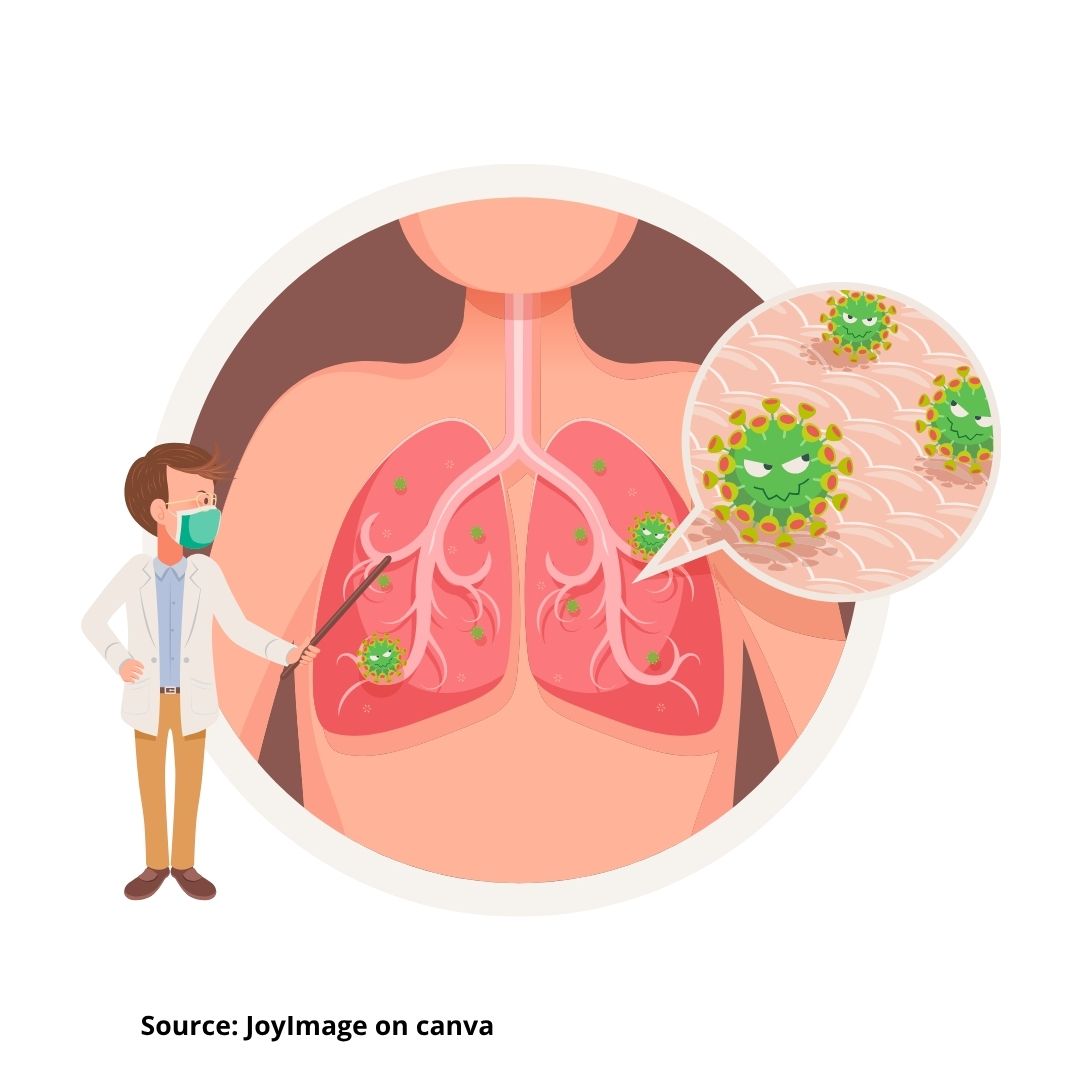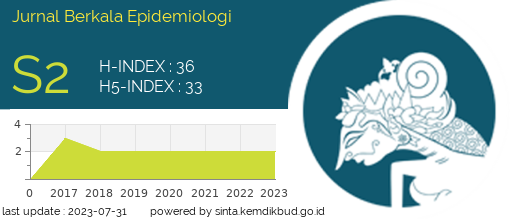ANALYSIS OF TUBERCULOSIS PATIENT CHARACTERISTICS OF GORONTALO CITY HOSPITAL USING K-MEANS CLUSTERING METHOD
Analisis Karakteristik Pasien Tuberkulosis Rumah Sakit Kota Gorontalo Menggunakan Metode K-Means Clustering

Downloads
Background: Tuberculosis (TBC) is a major health problem in Indonesia, especially in Gorontalo, with high spread due to poor ventilation, overcrowding, and unhealthy lifestyles. Purpose: To analyze the characteristics of TB patients in one of Gorontalo City's hospitals using K-Means Clustering. Methods: Data including age, gender, TBC history, HIV status, diabetes history, hypertension, drug resistance, drug side effects, and treatment results were analyzed for the number of clusters using the K-Means method because it is effective in grouping data based on similarity, easy to implement, and works well on large datasets. Results: The analysis resulted in three clusters. Cluster 0 (219 individuals): majority female (63.50%), mean age 45.37 years, low address score (0.49), low resistance and therapy (6.40%), no comorbidities, all experienced side effects (100%), and survival rate 4.10%. Cluster 1 (150 individuals): mean age 52.21 years, higher address score (0.77), resistance 7.30%, therapy 5.30%, comorbidities 100%, all experienced adverse events, and survival rate 4.70%. Cluster 2 (98 individuals): mean age 48.58 years, address score 0.65, very low resistance and therapy (2%), no side effects, 42.90% had comorbidities, and the highest survival rate (12.20%). Conclusion: Three clusters were obtained from the analysis using K-Means. Clustering supports specific interventions such as comorbidity management or intensive surveillance, improving TB control programs in Gorontalo.
Furin J, Cox H, Pai M. Tuberculosis. Lancet. 2019 Apr;393(10181):1642–56.
Falzon D, Zignol M, Bastard M, Floyd K, Kasaeva T. The impact of the COVID-19 pandemic on the global tuberculosis epidemic. Front Immunol. 2023;14:1234785.
Perkins A. Tuberculosis facts. Nurs Made Incred Easy! [Internet]. 2020 Jan;18(1):44–50. Available from: https://journals.lww.com/10.1097/01.NME.0000613628.36961.64
Nadjamuddin M, Junita N. Find Tuberculsis treat it until it is healed. EJOIN J Pengabdi Masy. 2023;1(10):1236–40.
Nurany H, Raharjo M, Adi MS. Environmental quality factors with the incidence of pulmonary tuberculosis: A literature review. J Serambi Eng. 2022;7(3):4–11.
Helyani H, Tosepu R, Effendy DS. Tuberculosis epidemiology and medical treatment efforts in Indonesia in the year 2020. In: 3rd International Conference on Advance & Scientific Innovation ICASI - Life Sciences Chapter. 2022. p. 7–13.
Yosua MI, Ningsih F, Ovany R. Relationship with house environmental conditions event of Tuberculosis (TB) lungs. J Surya Med. 2022;8(1):136–41.
Gorontalo Provincial Health Office. Health profile 2022. Gorontalo; 2023.
Pakaya R. Factors related to Pulmonary Tuberculosis Incident in Public Health Center of Limboto Year 2018. KESMAS UWIGAMA J Kesehat Masy. 2020 Jul 9;6(1):1–13.
Wang Y, Zheng D. The importance of precision medicine in modern molecular oncology. Clin Genet. 2021;100(3):248–57.
Denny JC, Collins FS. Precision medicine in 2030—seven ways to transform healthcare. Cell. 2021;184(6):1415–9.
Choi D, Xiang A, Ozturk O, Shrestha D, Drake B, Haidarian H, et al. Patient clustering via integrated profiling of clinical and digital data. In: Proceedings of the 32nd ACM International Conference on Information and Knowledge Management. 2023. p. 3818–22.
Dong B, He Z, Li Y, Xu X, Wang C, Zeng J. Improved conventional and new approaches in the diagnosis of tuberculosis. Front Microbiol. 2022;13:924410.
Kafle MP. Treating tuberculosis in special situations. Bangladesh J Med. 2023;141–2.
Li X, van Giessen A, Altunkaya J, Slieker RC, Beulens JWJ, ‘t Hart LM, et al. Potential value of identifying type 2 diabetes subgroups for guiding intensive treatment: a comparison of novel data-driven clustering with risk-driven subgroups. Diabetes Care. 2023;46(7):1395–403.
Tchakounte Youngui B, Tchounga BK, Graham SM, Bonnet M. Tuberculosis Infection in Children and Adolescents. Pathogens. 2022 Dec 9;11(12):1512.
Marlina L, Darmansyah D. Descriptive study of certainty level towards risk of Tuberculosis disease in productive ages. KnE Life Sci. 2021 Mar 15;6(1 SE-Articles):1063–8.
Togun T. Childhood tuberculosis in high burden settings. EBioMedicine. 2021 Jan;63:103181.
Mustapha MG, Ashir GM, Rabasa AI, Farouk AG, Elechi HA, Alhaji MA. Childhood tuberculosis: characteristics and peculiarities. Niger J Paediatr. 2020 Aug 6;47(3):190–200.
Whittaker E, López-Varela E, Broderick C, Seddon JA. Examining the complex relationship between tuberculosis and other infectious diseases in children. Front Pediatr. 2019 Jun 25;7:233.
Di Gennaro F, Vittozzi P, Gualano G, Musso M, Mosti S, Mencarini P, et al. Active pulmonary tuberculosis in elderly patients: a 2016–2019 retrospective analysis from an Italian referral hospital. Antibiotics. 2020 Aug 7;9(8):489.
Olmo-Fontánez AM, Turner J. Tuberculosis in an aging world. Pathogens. 2022 Sep 26;11(10):1101.
Hase I, Toren KG, Hirano H, Sakurai K, Horne DJ, Saito T, et al. Pulmonary tuberculosis in older adults: increased mortality related to tuberculosis within two months of treatment initiation. Drugs Aging. 2021;38(9):807–15.
Kunoor A, Reddy SC, Gopalakrishnan V, Rakesh PS, Kadayara AR, Haridas N, et al. Burden of comorbidity and treatment outcome in tuberculosis – a descriptive study from a tertiary care center, Kerala, India. Pulmon. 2023;25(2).
Chen Q, Che Y, Xiao Y, Jiang F, Chen Y, Zhou J, et al. Impact of multimorbidity subgroups on the health care use and clinical outcomes of patients with tuberculosis: a population-based cohort analysis. Front Public Heal. 2021 Oct 8;9:756717.
Cáceres G, Calderon R, Ugarte-Gil C. Tuberculosis and comorbidities: treatment challenges in patients with comorbid diabetes mellitus and depression. Ther Adv Infect Dis. 2022 Jan 20;9:1–17.
Vázquez García JC, Sada Díaz E, Rivera Martínez E, Narváez Porras O, Salazar Lezama MA. [Tuberculosis associated with HIV infection]. Rev Invest Clin. 1994;46(6):473–7.
Telisinghe L, Ruperez M, Amofa-Sekyi M, Mwenge L, Mainga T, Kumar R, et al. Does tuberculosis screening improve individual outcomes? A systematic review. EClinicalMedicine. 2021 Oct;40:101127.
Lewicki J, Religioni U, Merks P. Evaluation of the community pharmacy comorbidities screening service on patients with chronic diseases. Patient Prefer Adherence. 2021;15:1611–9.
Leddy AM, Jaganath D, Triasih R, Wobudeya E, Bellotti de Oliveira MC, Sheremeta Y, et al. Social determinants of adherence to treatment for tuberculosis infection and disease among children, adolescents, and young adults: a narrative review. J Pediatric Infect Dis Soc [Internet]. 2022 Oct 31;11(Supplement_3):S79–84. Available from: https://academic.oup.com/jpids/article/11/Supplement_3/S79/6775664
- Every manuscript submitted to must observe the policy and terms set by the Jurnal Berkala Epidemiologi
- Publication rights to manuscript content published by the Jurnal Berkala Epidemiologi is owned by the journal with the consent and approval of the author(s) concerned. (download copyright agreement)
- Complete texts of electronically published manuscripts can be accessed free of charge if used for educational and research purposes according to copyright regulations.

JBE by Universitas Airlangga is licensed under a Creative Commons Attribution-ShareAlike 4.0 International License.























